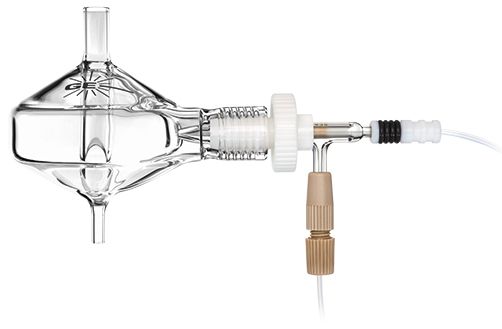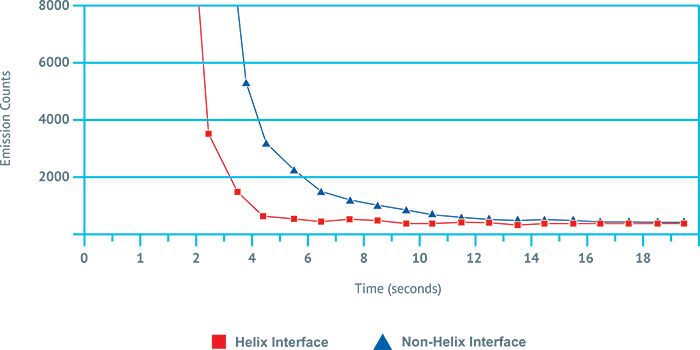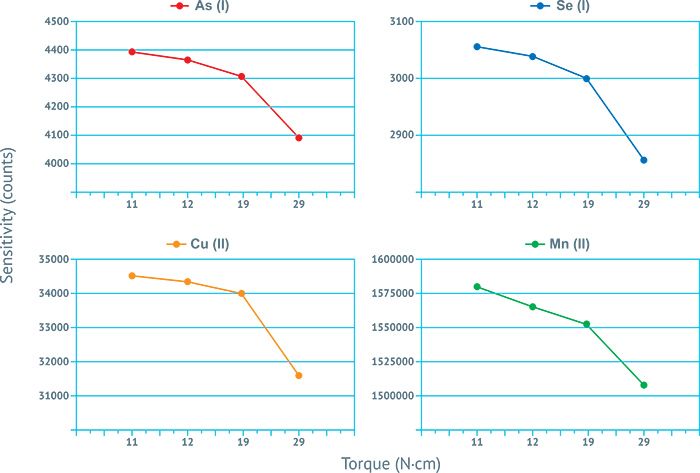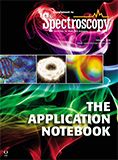Helix CT ICP Spray Chamber with ConstantTorque Technology Provides Consistent Day-to-Day Analytical Performance
Application Notebook
Glass Expansion revolutionized spray chamber design for the ICP-OES and ICP-MS analyst by introducing cyclonic spray chambers. Prior to the Glass Expansion Tracey™ cyclonic spray chamber, Scott-style spray chambers were the standard option provided with your ICP. The design of Glass Expansion's cyclonic spray chambers helps the ICP analyst achieve sensitivity gains, reduced washout times, and reduced matrix effects not possible with other designs.
This article will provide a summary of Glass Expansion's unique cyclonic spray chamber features and describe the advantages of the new Helix™ CT ICP spray chamber with ConstantTorque™ technology.
Traditionally, ICP-OES and ICP-MS sample introduction systems have relied on o-rings to form a gas-tight seal between the nebulizer and spray chamber. There are several drawbacks with an o-ring seal, such as:
- Potential for contamination due to dead volume around the o-ring seal
- Chemical resistivity of strong acids and organic solvents
- The o-rings are difficult to replace, often requiring tools
- Bonding to the nebulizer can result in breakage
The evolution of Glass Expansion cyclonic spray chamber design, specifically the advantages of the o-ring free Helix nebulizer-spray chamber interface were summarized in a 2014 article (1). In addition to the Helix interface, the benefits of each Glass Expansion cyclonic spray chamber model are detailed (1), making it easy for the ICP analyst to select the optimum spray chamber to suit their application needs. Glass Expansion is now pleased to introduce the new Helix CT (ConstantTorque) spray chamber, which provides a constant, reproducible, inert, gas-tight seal between the nebulizer and spray chamber (Twister with Helix CT shown in Figure 1).

Figure 1: Helix CT ICP spray chamber.
The main feature of the Helix CT spray chamber is a new Helix locking screw with built-in torque control mechanism that allows for a consistent seal of the PTFE ferrule against the nebulizer-making it impossible to overtighten or undertighten while ensuring a gas-tight seal each and every time. A new PressFit PTFE ferrule provides a chemically inert seal around the nebulizer, which is immune to strong acids and organic solvents routinely used in ICP sample preparation. The new Helix CT cyclonic spray chamber by Glass Expansion, therefore, eliminates all the drawbacks of the o-ring nebulizer seal, while improving user safety by preventing broken nebulizers.
The new Helix CT nebulizer interface is also simple to use:
- Fully insert the nebulizer into the Helix CT interface, until the nebulizer side-arm comes into contact with the molded-in positive stop.
- Hand-tighten the Helix CT locking screw until the ConstantTorque mechanism clicks, indicating a secure, gas-tight seal.
Results
An Agilent 5100 simultaneous dual view ICP-OES was used in combination with the SeaSpray DC nebulizer and Twister cyclonic spray chamber with Helix CT to evaluate washout performance, and the effects of nebulizer depth and torque applied to the nebulizer seal.
The Helix CT is the only nebulizer-spray chamber interface that significantly reduces the dead volume around the nebulizer. This unique design minimizes washout time with highly concentrated samples, reducing sample-to-sample carryover and improving sample throughput. Figure 2 compares the time required to washout a 10 ppm Molybdenum standard with the Helix CT interface and a "Brand-X" spray chamber with an o-ring interface. The results show that with the Helix nebulizer interface a 10 ppm standard can be washed out in as little as 4 s, whereas "Brand-X" takes 16 s. One can expect this time to significantly increase for more troublesome or "sticky" elements that are more prone to carryover issues.

Figure 2: 10 ppm Mo washout comparison between Helix and non-Helix spray chambers.
Glass Expansion's new Helix CT design maintains the positive stop of the original Helix to ensure that the nebulizer is inserted to the correct and optimum depth within the spray chamber. In addition to nebulizer depth, the torque applied to the nebulizer seal is also critical. The data shown in Figure 3 highlights the effects of torque applied to the nebulizer seal versus the observed sensitivity. The applied torque was increased incrementally from 11 N·cm to 29 N·cm. As the torque applied to the nebulizer seal increases, the sensitivity decreased on average by 5%, with greatest difference being 8% (Cu II). The new Helix CT locking screw is set to the optimum torque and will seal the PressFit PTFE ferrule against the nebulizer to the same torque each day. This allows your ICP to achieve the same nebulizer performance every day.

Figure 3: Helix CT interface sensitivity versus torque.
Conclusions
The results from our study show how dead volume around the nebulizer seal can affect washout efficiency, and ICP sensitivity is affected by both nebulizer depth within the spray chamber and the torque applied to the nebulizer seal. If consistent performance is crucial to your ICP laboratory, the new Helix CT spray chamber is your solution. The Helix CT spray chamber provides unparalleled, reproducible day-to-day ICP analytical performance.
Glass Expansion will now equip all of its glass, PFA, and PTFE spray chambers with the new Helix CT interface. However, if you already have a Helix spray chamber, you can easily upgrade to the Helix CT interface. The new Helix CT locking screw and PressFit PTFE ferrule are fully compatible with all Glass Expansion Helix style spray chambers. Achieving consistent day-to-day analytical performance in your ICP laboratory is just a click away with the new Helix CT cyclonic spray chamber, learn more at www.geicp.com/HelixCT and upgrade your ICP today.
Reference
(1) Glass Expansion October 2014 Newsletter, "ICP Spray Chamber Update." http://www.geicp.com/site/GE_Newsletter/GE_Newsletter_October_2014/pubData/source/GE0283%20GE%20Newsletter%20October%202014.pdf.

Glass Expansion Inc.
4 Barlows Landing Road, Unit 2A, Pocasset, MA 02559
tel. (508) 563-1800, fax (508) 563-1802
Website: www.geicp.com

Best of the Week: AI and IoT for Pollution Monitoring, High Speed Laser MS
April 25th 2025Top articles published this week include a preview of our upcoming content series for National Space Day, a news story about air quality monitoring, and an announcement from Metrohm about their new Midwest office.
LIBS Illuminates the Hidden Health Risks of Indoor Welding and Soldering
April 23rd 2025A new dual-spectroscopy approach reveals real-time pollution threats in indoor workspaces. Chinese researchers have pioneered the use of laser-induced breakdown spectroscopy (LIBS) and aerosol mass spectrometry to uncover and monitor harmful heavy metal and dust emissions from soldering and welding in real-time. These complementary tools offer a fast, accurate means to evaluate air quality threats in industrial and indoor environments—where people spend most of their time.